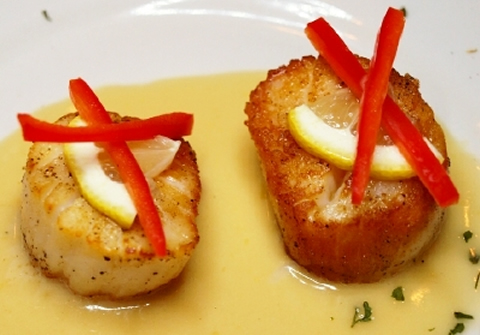 Our annual survey of seafood in Southeast Louisiana this year counts down the 33 best seafood species enjoyed more often in our restaurants than at home. Sea scallops--the big ones--have become omnipresent on local menus, even though they come from waters far away from New Orleans. But scallops were almost unknown to restaurant diners until about fifteen years ago. They come mostly from the waters off New England and the Maritime provinces of Canada. Air shipping of seafood makes it possible for us to enjoy fresh scallops in our restaurants, and sometimes even from our grocery stores.
Our annual survey of seafood in Southeast Louisiana this year counts down the 33 best seafood species enjoyed more often in our restaurants than at home. Sea scallops--the big ones--have become omnipresent on local menus, even though they come from waters far away from New Orleans. But scallops were almost unknown to restaurant diners until about fifteen years ago. They come mostly from the waters off New England and the Maritime provinces of Canada. Air shipping of seafood makes it possible for us to enjoy fresh scallops in our restaurants, and sometimes even from our grocery stores.

#10: Sea Scallops
The restaurants that are careful about what seafood they buy, the goal is to find what are known as "dry-pack" scallops. These are the ones that haven't been marinated in preservatives. Dry-pack scallops include diver scallops and day-boat scallops, which are collected in the daily search for live scallops, then go straight to market.
Unfortunately, many restaurants and most retail seafood sellers are still selling the treated scallops. Like as not, those are the ones you'll see in the supermarkets. More on that--and the little bay scallops, too--later.
Back to the good news. The best sea scallops are the big ones. They come from the Atlantic in the same parts of the Northeast that give us good lobsters. They range in size from about an inch across to the size of a petite filet mignon.
Scallops, like most mollusks, veer from the general seafood rule that smaller is better. I find the biggest ones most interesting. When cooked, those have the superb sweet flavor of fresh shellfish, with just a light searing at the outside. (They should bulge at the sides when cooked.) They're also good raw as sashimi.
The part of the scallop that we eat is analogous to the eye of an oyster. It's the adductor muscle, the one that keeps the shell closed. Only rarely do you see the entire surrounding tissue left intact. If you try that, you learn why we only eat the white part.
Before cooking at home, wash scallops exceedingly well. They sometimes contain fine sand. It's disconcerting to enjoy the flavor of a scallop and then be put off by a gritty sensation in chewing. Even in good restaurants I find this now and then.
Once in a very great while, scallops have the orange roe sac attached. Depending on which chef you ask, this is either wonderful or something to be got rid of. I like it, perhaps as much for its rarity than its intrinsic goodness.
Unacceptable Alternatives. The little bay scallops you see in chain restaurants and in Florida are about the size of miniature marshmallows. Although they are prized in the Boston and Cape Cod area when they're fresh in season, almost all bay scallops you're likely to find have been either frozen or treated with a phosphate chemical. The chemical is so effective that sometimes you can't get the treated scallops to brown, no matter how hot the pan is.
 Our annual survey of seafood in Southeast Louisiana this year counts down the 33 best seafood species enjoyed more often in our restaurants than at home. Sea scallops--the big ones--have become omnipresent on local menus, even though they come from waters far away from New Orleans. But scallops were almost unknown to restaurant diners until about fifteen years ago. They come mostly from the waters off New England and the Maritime provinces of Canada. Air shipping of seafood makes it possible for us to enjoy fresh scallops in our restaurants, and sometimes even from our grocery stores.
Our annual survey of seafood in Southeast Louisiana this year counts down the 33 best seafood species enjoyed more often in our restaurants than at home. Sea scallops--the big ones--have become omnipresent on local menus, even though they come from waters far away from New Orleans. But scallops were almost unknown to restaurant diners until about fifteen years ago. They come mostly from the waters off New England and the Maritime provinces of Canada. Air shipping of seafood makes it possible for us to enjoy fresh scallops in our restaurants, and sometimes even from our grocery stores.
